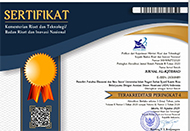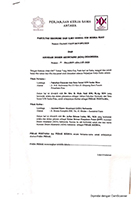MEMAHAMI PRAKTEK BAGI-HASIL KEB MASYARAKAT KAMPAR RIAU (Sebuah Pendekatan Etnografi)
Abstract
This study is aimed to grasp the meaning of a rubber revenue-sharing
from the point of view of people who understand the revenue-sharing practice in
Kampar community through participatory observation. Additionally, it is aimed to
deepen the understanding of revenue-sharing practice in Kampar Riau
community. This study uses a qualitative method with Etnography approach. Data
were collected through participation observation and open in-depth interviews.
The data were analyzed using Spradley model (1997), with includes domain
analysis, taxonomic analysis, componential analysis and cultural analysis. The
results of this study were that gotah revenue-sharing is revenue-sharing
containing the value of KESOJUKAN (Keadilan/Justice, Kesosialan/Socialism,
Kejujuran/Honesty and Keamanahan/Trustworthiness) in which Gotah revenue-sharing is a traditional custom practiced by generation and based on Islamic
values.
from the point of view of people who understand the revenue-sharing practice in
Kampar community through participatory observation. Additionally, it is aimed to
deepen the understanding of revenue-sharing practice in Kampar Riau
community. This study uses a qualitative method with Etnography approach. Data
were collected through participation observation and open in-depth interviews.
The data were analyzed using Spradley model (1997), with includes domain
analysis, taxonomic analysis, componential analysis and cultural analysis. The
results of this study were that gotah revenue-sharing is revenue-sharing
containing the value of KESOJUKAN (Keadilan/Justice, Kesosialan/Socialism,
Kejujuran/Honesty and Keamanahan/Trustworthiness) in which Gotah revenue-sharing is a traditional custom practiced by generation and based on Islamic
values.
Keywords
Revenue-sharing;rubber plantations;ethnography
Full Text:
PDFDOI: http://dx.doi.org/10.24014/jiq.v10i2.3115
Refbacks
- There are currently no refbacks.














